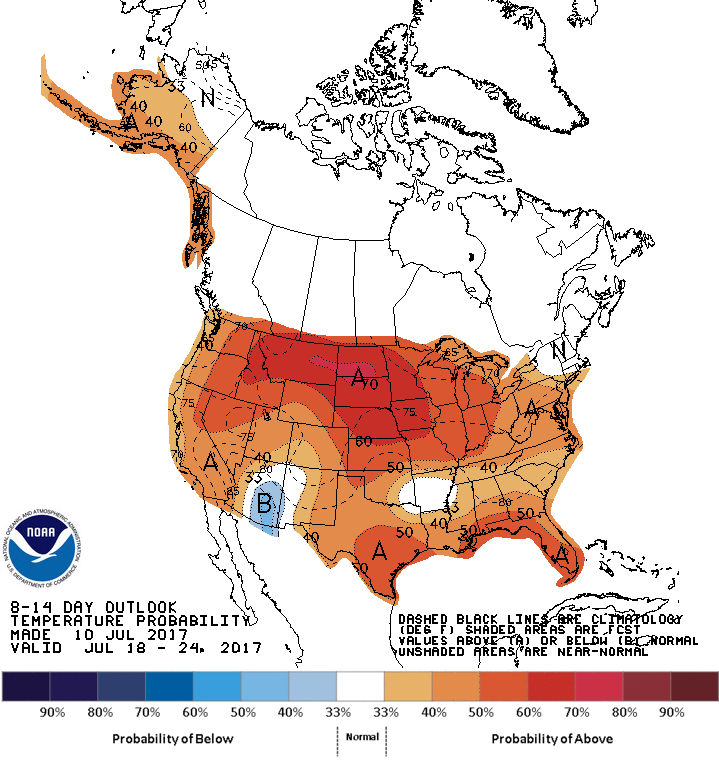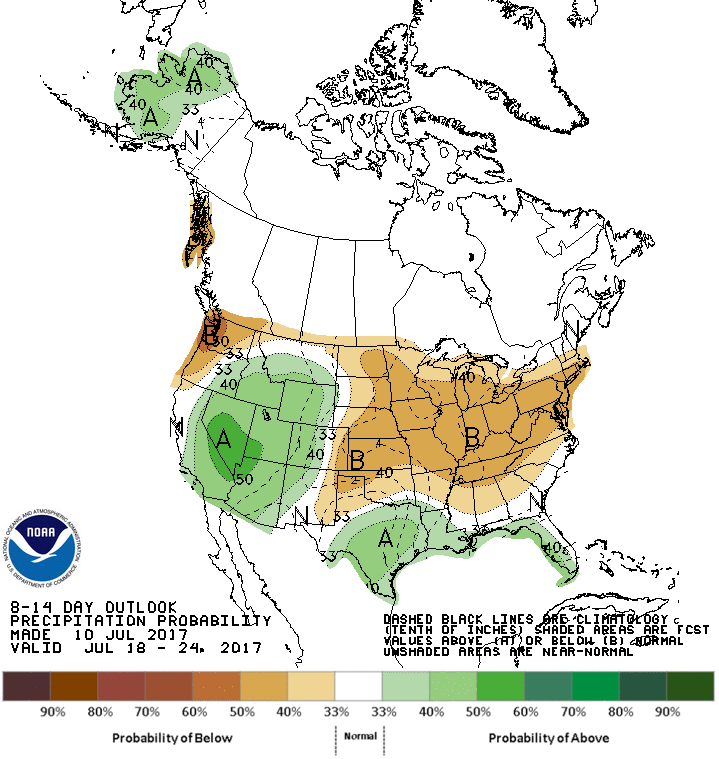The take-aways from the July 10 crop conditions report were mainly negative for production.
Condition ratings generally worsened, with spring wheat in the worst shape because of its concentration in the dry northern plains.
| National Crop |
Percent poor/very poor |
Percent good/excellent |
|
As of July 9 |
As of July 2 |
As of July 9 |
As of July 2 |
| Corn |
10 |
8 |
65 |
68 |
| Soybeans |
11 |
9 |
62 |
64 |
| Grain sorghum |
6 |
3 |
63 |
62 |
| Spring wheat |
39 |
33 |
35 |
37 |
South Dakota remains the trouble spot in the area served by Farm Credit Services of America (FCSAmerica). Only 37 percent of corn is in the top categories while 27 percent is in the bottom two. Only 2 percent is silking, compared with a five-year average of 11 percent.
Likewise, South Dakota soybeans are rated 67 in the top categories and 63 percent in the bottom. Sorghum in the state is 9 and 34 percent for top and bottom categories, respectively. Spring wheat has worsened from 11 percent to 10 percent in the top categories and from 65 to 72 percent in the bottom.
Pasture and range condition also has worsened. The top end lost three points and stands at 54 percent, while the bottom end gained two points to 17 percent. This is a possible explanation why beef lenders report brisk feeder cattle sales in some locations of FCSAmerica’s territory.
Progress mixed
Corn silking in the 18 grain states is well behind average at 19 percent vs. 27 percent. Here is a look at silking rates In the areas served by FCSAmerica and Frontier Farm Credit:
Iowa, 7 percent compared to 20 percent on average
Kansas 36 percent vs. 42 percent average
Nebraska 14 percent vs. 23 percent average
South Dakota 2 percent vs. 11 percent average
Thirty-four percent of soybeans are blooming, two points ahead of average, and 7 percent are setting pods, also two points ahead, in the 18 states. Iowa, Kansas and Nebraska all are well ahead of normal percentage blooming, while South Dakota is nine points behind.
Spring wheat heading stands at 79 percent against an average 74 percent in the six reporting states, with South Dakota at 98 vs 92 percent.
USDA reports winter wheat harvest at 76 percent, two points ahead of average. Kansas is four points ahead of average at 93 percent and Nebraska has reached 52 percent, well ahead of its usual 38 percent.
Shortages in soil moisture
Dry conditions are spreading. USDA’s reported soil moisture readings for South Dakota, Nebraska and Wyoming are concerning.
| States |
Percent topsoil –
short/very short |
Percent subsoil –
short/very short |
| 48 states |
37 |
31 |
| Iowa |
40 |
29 |
| Kansas |
30 |
20 |
| Nebraska |
65 |
54 |
| South Dakota |
79 |
71 |
| Wyoming |
52 |
48 |
Weather Worrisome
More worrisome perhaps is the eight- to 14-day weather outlook for July 8 to 24 from the Climate Prediction Center. Most of the country has a high probability of above-normal temperatures, paired with odds that are somewhat lower but still favor below-normal rainfall. This could keep markets on edge, especially as more corn reaches the silking stage.


Maps source: http://www.cpc.ncep.noaa.gov/products/predictions/814day/

